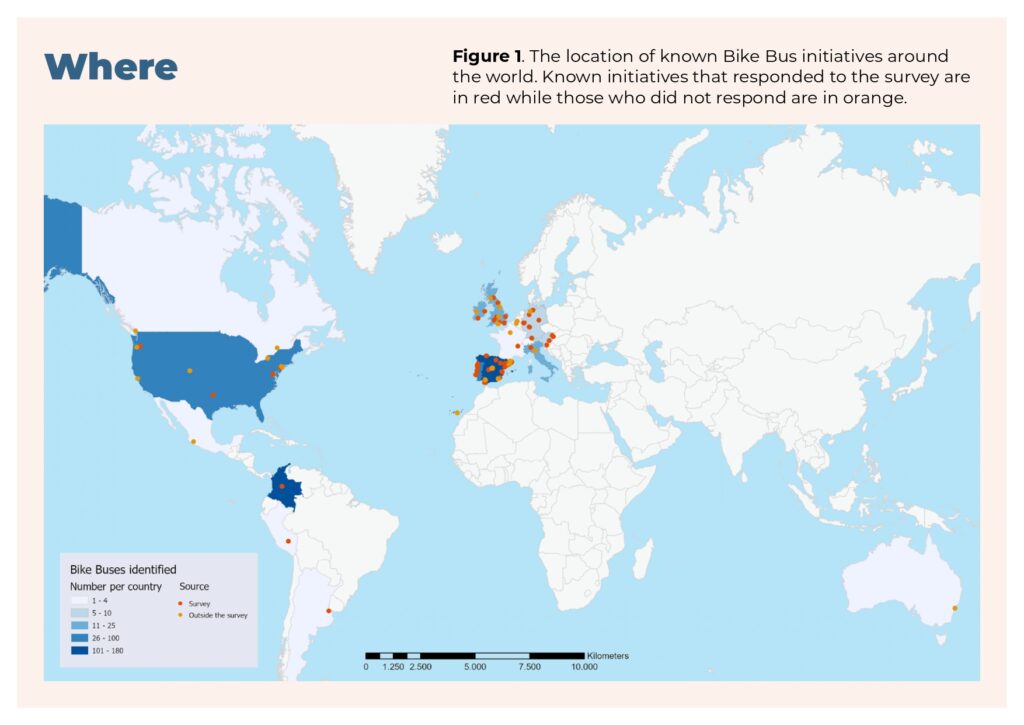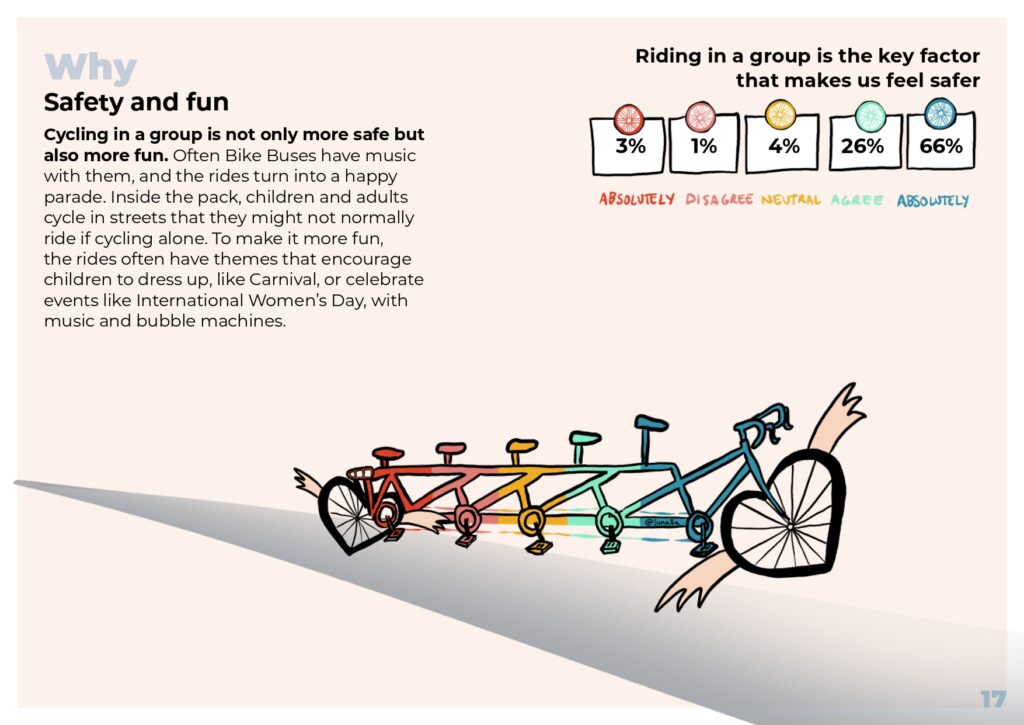Bike Bus initiatives have exploded around the world, forcing us to ask the questions: why here and why now? What are the characteristics of the Bike Bus global movement? And what can we learn from the experiences around the world?
A Bike Bus is a group of children who ride their bikes to school following a route with stops and timetables. The idea is not new, but with over 470 Bike Buses found worldwide, transporting approximately 32,000 children to school per week in the last three years, the Bike Bus movement has gained momentum globally at a time when climate change and active transportation are becoming mainstream.
Bike Bus organizers are mostly parents and cycling activists, who have promoted their initiatives through social media and Parent-Teacher Associations. Cycling in a group provides safety-in-numbers, making cyclists more visible and giving them a sense of collective legitimacy to use the road. Initially conceived to shelter children from traffic, Bike Buses have evolved into a celebration of cycling and a demand for more child-friendly cities.
The new report, A Global Survey of Bike Bus Initiatives [PDF] summarizes key findings from a global assessment of the bike bus community. We have mapped known Bike Bus initiatives, and aimed to learn about their features, origins, support and long-term sustainability.
Globally the average Bike Bus has:
- 10 children
- 7 adults
- travels 3 km
- lasts 20 min
- runs once a week
Where are the Bike Buses located? The Bike Buses we could identify were predominantly in Europe and the USA, although it is likely that many more remain unaccounted for.

Where did the idea start? As far as we can tell, the first formal bike bus we could document is from Brecht, Belgium in 1998, although it is possible that other initiatives may have pre-dated this one. The municipality of Bogotá, Colombia, launched the first large-scale network in 2014, with more than 140 Bike Bus routes, still functioning. The most recent surge of Bike Buses took place around 2020-2021, starting in the Catalonia and inspiring other initiatives such as the Shawlands Bike Bus (Scotland, UK), Alameda Bike Bus (Portland, US), and BiciBus Frankfurt (Germany), who in turn inspired more Bike Buses.

What about road safety? Most cities are not designed for children to safely ride their bike to school. Bike Bus is often a response to inadequate cycling infrastructure in our cities and an unfair allocation of road space to motor vehicles.

How far do most bike buses travel? Most bike bus routes are between 1 and 2 km long, although the global average is higher (3 km), because longer routes pull up the average. Getting the distance right is critical because rides that are too long may be too challenging for children and distances too short are easier to walk.

How often do Bike Buses cycle together? Almost 80% of Bike Buses run once a week or more. Most Bike Buses (60%) pedal together once a week and 10% run every day.

Is the route safe without Bike Bus? No. Bike Bus is critical to making the route to school feel safe. 80% of Bike Bus organizers reported that the route is not safe without the support from the Bike Bus community.

What is the value of riding in a group? Bicycling in a group is not only more safe but more fun. 92% of Bike Bus organizers agree that riding in a group is a key factor that makes participants feel safer. But parents and children also come for the fun.

Is Bike Bus a form of advocacy? Yes. We found that 93% of Bike Bus organizers see their work as a form of advocacy that demands child friendly streets. While some routes are practical for parents to bring their children to school, many are not necessarily practical, but they are motivated by the fun and performative aspects of riding in a Bike Bus.

What support do they receive? The support for Bike Bus initiatives from local governments varied and was context dependent. Generally, Bike Bus organizers reported engaging in dialogue with the City Council was easy, but ultimately, few city governments were willing to make serious changes.

What about the long-term sustainability? Most Bike Bus organizers are concerned about the long-term sustainability of their initiative. Only 16% are confident that their Bike Bus is sustainable over the long-term. Some organizers argue that Bike Buses are not the end goal but rather the beginning of further change. Others envision turning Bike Buses into an official school transport service.

There remains much more to learn about how Bike Buses organize, operate, persist, and transform the cities where they cycle. Our future research will focus on understanding the impact of Bike Bus initiatives on families’ bicycle use and attitudes.
Simón-i-Mas, G., Martín, S., Honey-Rosés, J. (2024). A Global Survey of Bike Bus Initiatives. Institut de Ciència i Tecnologia Ambientals de la Universitat Autònoma de Barcelona (ICTA-UAB). City Lab Barcelona. [PDF]
The data collected for this study is accessible in Replication data for: A Global Survey of Bike Bus Initiative



We do Bike Bus in the name of BICYCLE TRAINS in schools where we have Bicycle Brigades (Bicycle clubs)
Hello Prakash! It is nice to hear from you! To connect with the global bike bus movement visit http://bikebussummit.org/